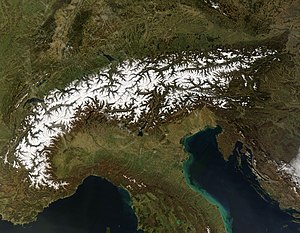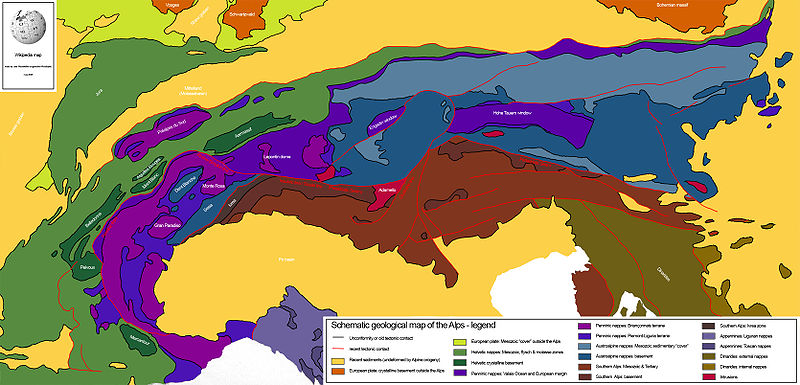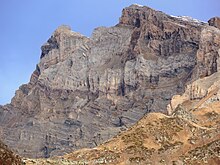Geology of the Alps
This article has multiple issues. Please help improve it or discuss these issues on the talk page. (Learn how and when to remove these template messages)
|


The Alps form part of a Cenozoic orogenic belt of mountain chains, called the Alpide belt, that stretches through southern Europe and Asia from the Atlantic all the way to the Himalayas. This belt of mountain chains was formed during the Alpine orogeny. A gap in these mountain chains in central Europe separates the Alps from the Carpathians to the east. Orogeny took place continuously and tectonic subsidence has produced the gaps in between.
The Alps arose as a result of the collision of the
Subsequently, the formation of the Mediterranean Sea covered terranes originating within the African plate south of the mountains.
Geologic boundaries
The Alps form a northward
The Alps continue fairly smoothly into the following related Alpine mountain ranges: the
Geologic structure
The Alps have a complex geology, but the general structure is the same as for other mountain ranges formed by continental collision.
Subdivisions
The Alps are often divided into
North of the Periadriatic seam, rocks from three main

Structural geology

Folds and thrusts north of the Periadriatic seam are generally directed to the north, the dominant vergence (direction of fold asymmetry) in these units is to the north. In the Southern Alps the thrusts are to the south so the vergence is dominantly southward.
The rocks of the Austroalpine nappes form most of the outcrops in the
In many spots in the central zone north of the Periadriatic seam large
Intrusions
In older rocks from the lower
Metamorphism
The rocks of the Helvetic and Austroalpine nappes and the southern Alps did not experience high grade
- they were originally from lower regions of the crust and got to the surface by amphibolite faciesat most.
- in the Austroalpine nappes eclogites occur that were formed during the Cretaceous period, in an early phase of mountain building called the Eo-Alpine orogeny. These are high-grade metamorphic rocks, but their metamorphism is unrelated to the (later) formation of the Alps.
Cenozoic eclogites do occur in the Penninic nappes, which contain material that has been through
Alpine (
Tectonic history
The Alps are a
Breakup of Pangaea
At the end of the
The effects of
Jurassic
In the early
In the late Jurassic the
When at the end of the Jurassic the Adriatic plate began to move toward the European plate, oceanic trenches formed in the eastern Alps. In these, deep marine sediments were deposited, such as radiolarites and lutites.
Eo-Alpine phase in the Cretaceous
The
As a result of this process, the soft layers of
In the late Cretaceous the first continental collision took place as the northern part of the Adriatic subplate collided with Europe. This is called the Eo-Alpine phase, and is sometimes regarded as the first phase of the formation of the Alps. The part of the Adriatic plate that was deformed in this phase is the material that would later form the Austroalpine nappes and the Southern Alps. In some fragments of the Piemont-Liguria Ocean now in the Penninic nappes an Eo-Alpine deformation phase can also be recognized.
Apart from the Eo-Alpine fold and thrust belt other regions were still in the marine domain during the Cretaceous. On the southern margins of the European continent shallow seas formed limestone deposits, that would later be (in the Alps) incorporated into the Helvetic nappes. At the same time sedimentation of
Paleocene and Eocene
When the Piemont-Liguria oceanic crust had completely subducted beneath the
Oligocene and Miocene
When the subducting
Meanwhile, the thrust front of the Penninic and Austroalpine nappes moved on, pushing all material in its way northward. Due to this pressure a
Adriatic plate started rotating counterclockwise.[3]
Quaternary
After subduction of oceanic crust of the European plate collision nearly completely stopped in the Western and Central Alps (See map Figure 2).,[3][4] These parts are still uplifted up to 2.5 mm/year in some areas.[5][6] It is thought it is mainly due to rebound after weight loss from melting ice caps after the last ice age, intensive erosion during glaciation and some processes in the lithosphere and mantle. Adriatic plate, pushed by the African plate, still rotates counterclockwise around the axis near Ivrea in northwestern Italy and is subducted in Eastern Alps and causes tectonic uplift (thrust) there.[3]
Geomorphology
The formation of the Alpine landscape seen today is a recent development – only some two million years old. Since then, five known ice ages have done much to remodel the region. The tremendous glaciers that flowed out of the mountain valleys repeatedly covered all of the Swiss plain and shoved the topsoil into the low rolling hills seen today. They scooped out the lakes and rounded off the limestone hills along the northern border.
The last great glacier advance in the Alps ended some 10,000 years ago, leaving the large lake now known as
Besides leaving an Arctic-like wasteland of barren rock and gravel, the huge moraine of material that was dropped at the front of the glaciers blocked huge masses of melt water that poured onto the central plain during this period. A huge lake resulted, flooding the region to a depth of several hundred meters for many years. The old shoreline can be seen in some places along the low hills at the foot of the mountains – the hills actually being glacial side-moraines. As the Aare, which now drains western Switzerland into the Rhine, eventually opened the natural dam, the water levels in the plain fell to near the present levels .
In the last 150 years humans have changed the flow and levels of all the rivers and most of the extensive wetlands and small lakes have disappeared under the effects of farming and other development.
It has been proposed that the height of mountains in the
Geologic research
The Alps were the first mountain system to be extensively studied by geologists, and many of the geologic terms associated with mountains and glaciers originated there. The term Alps has been applied to mountain systems around the world that exhibit similar traits.
Geophysics
In the 1980s and 1990s, a number of teams began mapping the structures in the lower crust by seismology. The result was a number of detailed geological cross-sections of the deep structures below the Alps. When seismic research is combined with insights from gravitational research and mantle tomography the subducting slab of the European plate can be mapped. Tomography also shows some older detached slabs deeper in the mantle.
See also
- Andean orogeny
- Swiss plateau
References
- ^ See for a detailed subdivision of the geologic units in the Alps for example (Schmid et al. 2004), (Compagnoni 2003), (Pfiffner 2009, pp. 25–27)
- ^ Schuster, Ralf; Stüwe, Kurt (2010). "Die Geologie der Alpen im Zeitraffer" (PDF). Mitteilungen des Naturwissenschaftlichen Vereines für Steiermark (in German). 140: 5–21.
- ^ S2CID 129726603.
- .
- PMID 27346228.
- S2CID 96447591.
- ISBN 978-0-444-53643-3.
Further reading
- Compagnoni, R. (2003). "HP metamorphic belt of the western Alps". Episodes. 26 (3): 200–204. .
- Sternai, P.; et al. (2019). "Present-day uplift of the European Alps: Evaluating mechanisms and models of their relative contributions". Earth-Science Reviews. 190: 589–604. hdl:10281/229017.
- Dal Piaz, G.V.; Bistacchi, A.; Massironi, M. (2003). "Geological outline of the Alps". Episodes. 26 (3): 175–180. .
- Frisch, W.; Dunkl, I.; Kuhlemann, J. (2000). "Post-collisional large-scale extension in the Eastern Alps". Tectonophysics. 327 (3): 239. .
- Pfiffner, O.A. (2009). Geologie der Alpen (in German). Bern/Stuttgart/Wien: Haupt Verlag. ISBN 978-3-8252-8416-9.
- .
- Schmid, Stefan M. "Description of the Western and Central Alps". Geologisch-Paläontologisches Institut, University of Basel. Archived from the original on 19 December 2005.
- Schmid, Stefan M.; Fügenshuh, Bernhard; Kissling, Eduard; Schuster, Ralf (2004). "Tectonic map and overall architecture of the Alpine orogen" (PDF). Eclogae Geologicae Helvetiae. 97: 93–117. S2CID 22393862. Archived from the original(PDF) on 28 November 2006.
- Schmid, S.M.; Kissling, E. (2000). "The arc of the western Alps in the light of geophysical data on deep crustal structure". Tectonics. 19 (1): 62. .
- Schmid, S.M.; Pfiffner, O.A.; Froitzheim, N.; Schönborn, G.; Kissling, E. (1996). "Geophysical-geological transect and tectonic evolution of the Swiss-Italian Alps" (PDF). Tectonics. 15 (5): 1036. .
- Stampfli, GM; Borel, GD; Marchant, R.; Mosar, J. (2002). Rosenbaum, G.; Lister, G.S. (eds.). "Western Alps geological constraints on western Tethyan reconstructions". Journal of the Virtual Explorer. 08. .
- Stampfli, GM (1993). "Le Briançonnais, terrain exotique dans les Alps?". Eclogae Geologicae Helvetiae (in French). 86: 1.
- Stampfli GM, Borel GD (2004). "The TRANSMED Transects in Space and Time: Constraints on the Paleotectonic Evolution of the Mediterranean Domain". In Cavazza W, Roure F, Spakman W, Stampfli GM, Ziegler P (eds.). The TRANSMED Atlas: the Mediterranean Region from Crust to Mantle. Springer Verlag. ISBN 978-3-540-22181-4.
- Ziegler, P.A. (1988). "Evolution of the Arctic-North Atlantic and the Western Tethys". American Association of Petroleum Geologists Memoir. 43.
External links
- Geophysical research and the geology of the Alps
- The tectonic evolution of the western and central Alps and their forelands, website of prof. S.M. Schmid
- Alpine geology
- Paleoreconstructions of the Alpine Tethys region, IGCP369 project website
- Platetectonic maps of the North Atlantic (including the Mediterranean) by Peter Ziegler
- Plate tectonic reconstruction of the opening and closing of the Valais and Ligurian Oceans, website of Christian Nicollet (in French)
